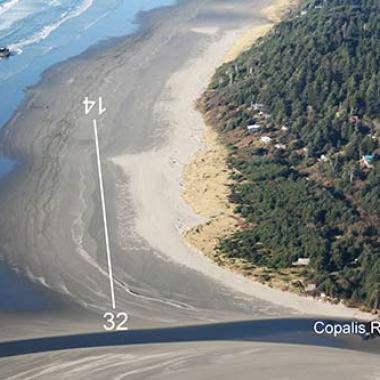Airport Alert
Use extreme caution and watch out for deposited debris, pedestrians, vehicles, and active wildlife in the vicinity. Odor from decaying vegetation or wildlife may be strong. Please observe the Olympic Coast National Marine Sanctuary airspace restrictions. Do not conduct repeated low-level passes.
Open year round. Watch for Razor Clam Digging Openings and increased vehicle and pedestrian activity on or in the vicinity of the airport.
Please check NOTAM’s and contact the Airport Manager at paul.wolf@wsdot.wa.gov or 360-618-2477 for additional questions.
Location
ID
Sponsor
Rules
Available information for airport
Description
The following information is for reference only and does not supersede federal or state aviation regulations or state park regulations. It is intended to assist pilots in making informed decisions when landing aircraft at this unique beach recreation area.
Background
Copalis Beach Airport is located along the northwest pacific coast line of Washington State within the boundaries of the North Beach Seashore Conservation Area, adjacent to the Olympic Coast National Marine Sanctuary near the mouth of the Copalis River. The Copalis Airport is the only known beach airport in Washington State where aircraft landing is legal. The North Beach Seashore Conservation Area is subject to the jurisdiction of the Washington State Parks and Recreation. Use of the beach airport is under the jurisdiction of the Washington State Department of Transportation’s (WSDOT) Aviation Division.
Where to land?
Through cooperation between WSDOT Aviation Division and the Ocean City State Park the landing area is designated between the mouth of the Copalis River to the south and north to the rocks. WSDOT has determined that ongoing river migration and ocean beach erosion has reduced the 4500 foot long by 150 foot wide runway by approximately 1,100 feet possibly more. Please check this website and airport facilities directory, for future updates to the runway length.
Orange reflective markers are installed near the north and south ends of the authorized landing area to assist with identification of the landing area. Standard traffic patterns should be observed.
Pilot in command, land at your own risk
As pilot in command you should consider the unique conditions of beach landing:
- Check local tide tables.
- Dark, wet sand at low tide is the hardest for landing.
- The dry, light-colored soft sand near the high tide mark should be avoided.
- Summer landings may experience softer wet sand area (less compact) and higher risk of getting stuck.
- Avoid operating in the razor clam beds.
- Over flight is recommended before landing to check for obstructions such as exposed rocks, debris and pedestrians.
- The landing area is shared with other beach users and activities.
- Park aircraft in a row along the high tide mark.
- The busiest time is during the summer months and during the winter clamming season.
- Announce your intentions on the common radio frequency.
- Do not park aircraft overnight due to tidal changes.
- Observe all state park regulations.
- Do not land south of the Copalis River. This is restricted Snowy Plover habitat area.
- Do not land north of the large Copalis Rock. This is restricted area.
- Do not scud run (low level flying) into the NOAA Olympic Coast National Marine Sanctuary restricted airspace. Normal takeoff and landings using traffic pattern altitude is acceptable, but please do not fly low up or down the coast line.
- After Labor Day, vehicles may be on the beach runway area.
- Please Report any unsafe conditions or incidents.
Fly friendly policies
Copalis Airport is a unique environment shared by many users. Pilots are encouraged to “Fly Friendly” at Copalis in consideration of local residents and visitors. In that spirit of cooperation aircraft operators should avoid activities that create a nuisance or conflict with other beach users.
Olympic Coast National Marine Sanctuary
Copalis Beach Airport is within the Olympic Coast National Marine Sanctuary. Aircraft operators should be aware of increased bird activity and airspace restrictions associated with the refuge during landing and departure. Before flying at Copalis, pilots are encouraged to check the applicable Aeronautical Chart for federal over flight guidance for flights over charted National Park, U.S. Fish and Wildlife and U.S. Forest Service areas. The regulations are available at:
http://olympiccoast.noaa.gov/protect/wildlifedisturbance/overflight.html
Facilities
Similar to other state backcountry airports, there are no facilities at the airport with the exception of the airport end markers, a sign-in area and a wind cone located near mid airport at the high tide line. The windsock and signs are checked and replaced as necessary at least twice a year due to extreme weather conditions and the corrosive salt water environment. The airport is routinely checked by State Parks Beach Rangers; however, weather and vandalism have been problems for the maintenance of the windsock and signs.
What to do and see at the beach
This is an excellent area for recreation, whether you are taking in the sights of the great Pacific Ocean, clam digging, surfing, fishing, or beach combing. No overnight camping is allowed at the airport.
Special aviation events and activities
For special aviation events and activities at the airport, notify WSDOT Aviation for review and approval. All state park beach rules apply.
Note: Portions of the Copalis beach are closed to vehicle access from April 15 through Labor Day. Permission for limited vehicle access within these dates is restricted to special events on a case-by-case basis only. To obtain permission for limited vehicle access during these dates, please contact Ocean City State Park at 360-289-3553, and WSDOT Aviation Division at 360-709-8015 for approval. Vehicle activity is at your own risk.
All information subject to use disclaimer.

